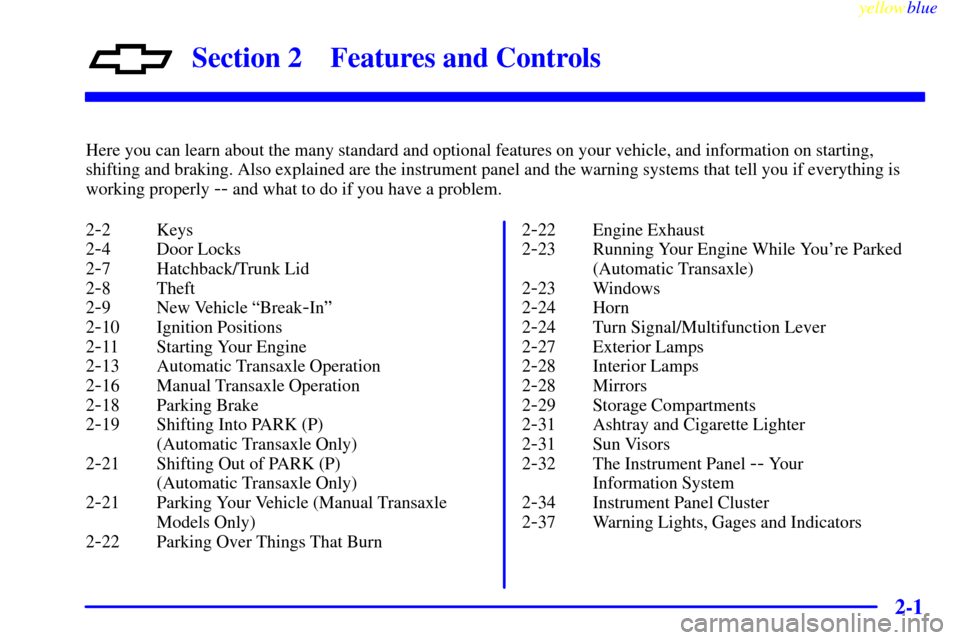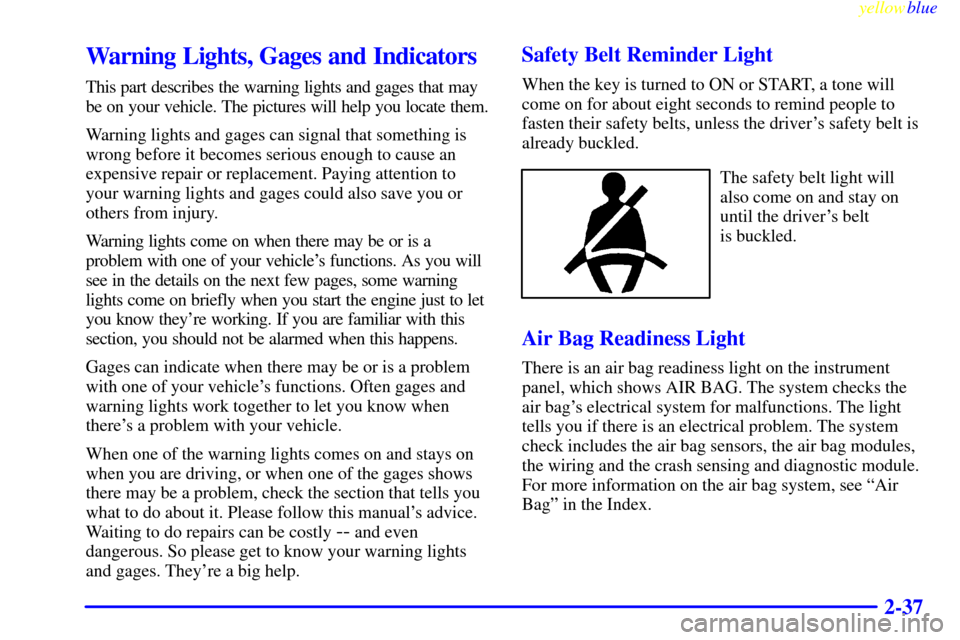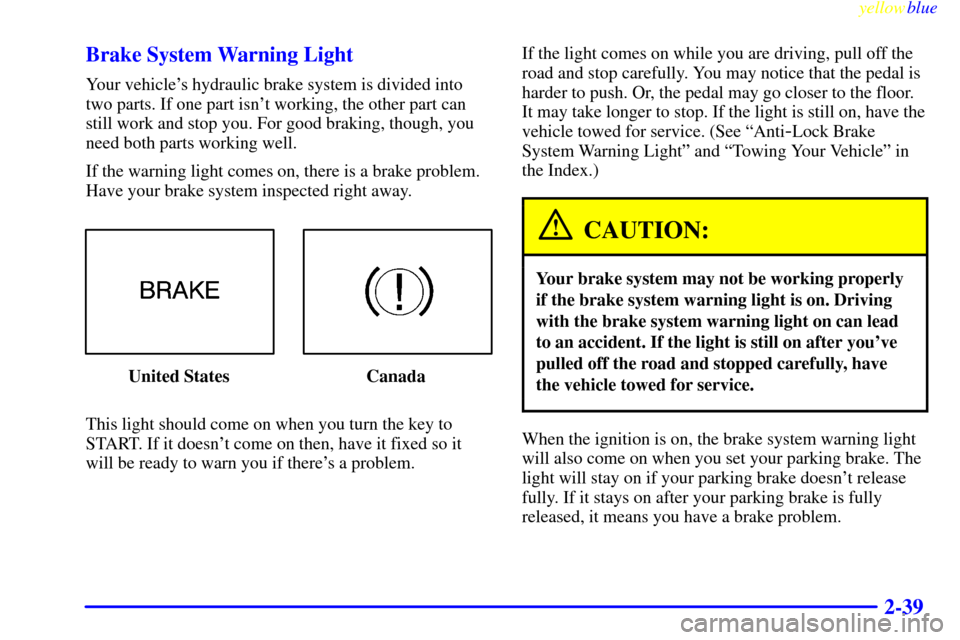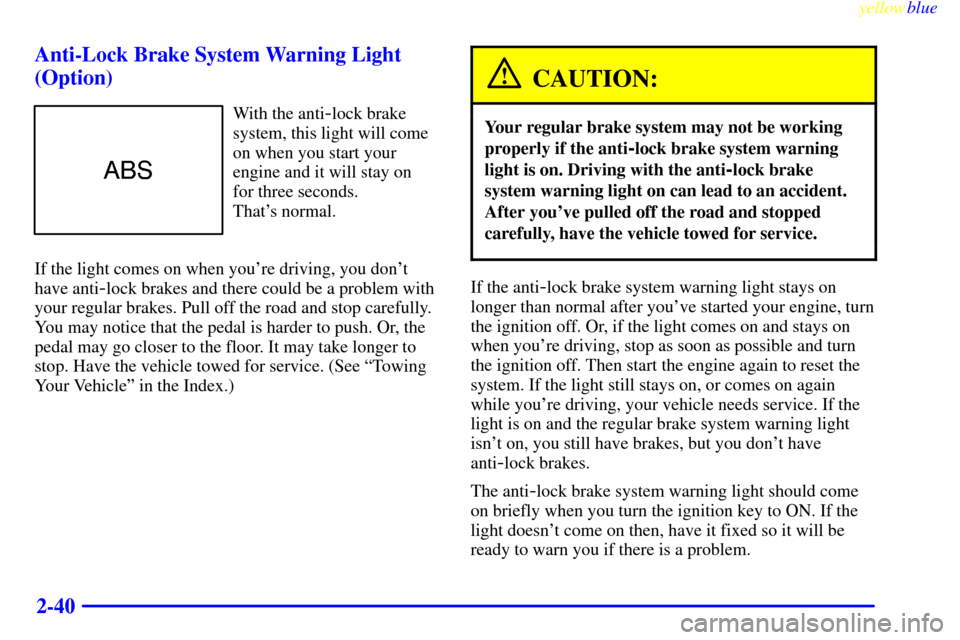Page 8 of 328
yellowblue
viii
For example,
these symbols
are used on an
original battery:
CAUTION
POSSIBLE
INJURY
PROTECT
EYES BY
SHIELDING
CAUSTIC
BATTERY
ACID COULD
CAUSE
BURNS
AVOID
SPARKS OR
FLAMES
SPARK OR
FLAME
COULD
EXPLODE
BATTERY
These symbols
are important
for you and
your passengers
whenever your
vehicle is
driven:
DOOR LOCK
UNLOCK
FASTEN
SEAT
BELTS
POWER
WINDOW
AIR BAG
These symbols
have to do with
your lamps:
MASTER
LIGHTING
SWITCH
TURN
SIGNALS
PARKING
LAMPS
HAZARD
WARNING
FLASHER
DAYTIME
RUNNING
LAMPS
FOG LAMPS
These symbols
are on some of
your controls:
WINDSHIELD
WIPER
WINDSHIELD
WASHER
WINDSHIELD
DEFROSTER
REAR
WINDOW
DEFOGGER
VENTILATING
FAN
These symbols
are used on
warning and
indicator lights:
ENGINE
COOLANT
TEMP
BATTERY
CHARGING
SYSTEM
BRAKE
COOLANT
ENGINE OIL
PRESSURE
ANTI-LOCK
BRAKES
Here are some
other symbols
you may see:
FUSE
LIGHTER
HORN
SPEAKER
FUEL
Vehicle Symbols
These are some of the symbols you may find on your vehicle.
Page 59 of 328

2-
yellowblue
2-1
Section 2 Features and Controls
Here you can learn about the many standard and optional features on your vehicle, and information on starting,
shifting and braking. Also explained are the instrument panel and the warning systems that tell you if everything is
working properly
-- and what to do if you have a problem.
2
-2 Keys
2
-4 Door Locks
2
-7 Hatchback/Trunk Lid
2
-8 Theft
2
-9 New Vehicle ªBreak-Inº
2
-10 Ignition Positions
2
-11 Starting Your Engine
2
-13 Automatic Transaxle Operation
2
-16 Manual Transaxle Operation
2
-18 Parking Brake
2
-19 Shifting Into PARK (P)
(Automatic Transaxle Only)
2
-21 Shifting Out of PARK (P)
(Automatic Transaxle Only)
2
-21 Parking Your Vehicle (Manual Transaxle
Models Only)
2
-22 Parking Over Things That Burn2
-22 Engine Exhaust
2
-23 Running Your Engine While You're Parked
(Automatic Transaxle)
2
-23 Windows
2
-24 Horn
2
-24 Turn Signal/Multifunction Lever
2
-27 Exterior Lamps
2
-28 Interior Lamps
2
-28 Mirrors
2
-29 Storage Compartments
2
-31 Ashtray and Cigarette Lighter
2
-31 Sun Visors
2
-32 The Instrument Panel -- Your
Information System
2
-34 Instrument Panel Cluster
2
-37 Warning Lights, Gages and Indicators
Page 68 of 328

yellowblue
2-10
Ignition Positions
CAUTION:
Leaving children in a vehicle with the ignition
key is dangerous for many reasons. A child or
others could be badly injured or even killed.
They could operate controls or even make the
vehicle move. Don't leave the keys in the vehicle
with children.
With the key in the ignition
switch, you can turn the
switch to four positions.
LOCK (A): This is the only position in which you can
remove the key. This locks your steering wheel, ignition
and automatic transaxle. Press in on the key as you turn
it toward you to LOCK.If you have an automatic transaxle, the ignition switch
can't be turned to LOCK unless the shift lever is in the
PARK (P) position.
ACC (ACCESSORY) (B): In this position, you can
operate some of your electrical power accessories. It
unlocks the steering wheel and ignition. Use this
position if your vehicle must be pushed or towed.
ON (C): This is the position to which the switch returns
after you start your engine and release the switch. The
switch stays in the ON position when the engine is
running. But even when the engine is not running, you
can use ON to operate your electrical power accessories
(including the heater) and to display some instrument
panel warning lights.
START (D): This position starts the engine. When the
engine starts, release the key. The ignition switch will
return to ON for normal driving.
Note that even if the engine is not running, ACC and
ON are on positions that allow you to operate your
electrical accessories, such as the radio.
A warning tone will sound if you open the driver's door
when the ignition is in ACC or LOCK and the key is in
the ignition.
Page 76 of 328
yellowblue
2-18
Parking Brake
The parking brake is located between the seats. To set
the parking brake, hold the brake pedal down and pull
up on the parking brake lever. If the ignition is on, the
brake system warning light will come on.
To release the parking brake, hold the brake pedal down.
Pull the parking brake lever up until you can press the
release button. Hold the release button in as you move
the lever all the way down.
NOTICE:
Driving with the parking brake on can cause
your rear brakes to overheat. You may have to
replace them, and you could also damage other
parts of your vehicle.
Page 91 of 328
yellowblue
2-33
1. Rear Window Wiper Switch (If Equipped)
2. Turn Signal/Multifunction Lever
3. Air Vent
4. Brightness Control
5. Horn
6. Hazard Warning Flasher
7. Instrument Cluster
8. Ignition Switch
9. Windshield Wiper/Washer Lever
10. Coinholder
11. Comfort Controls
12. Side Defroster Vent13. Glove Box
14. Audio System
15. Cigarette Lighter
16. Cupholder
17. Storage Compartment
18. Parking Brake Lever
19. Transaxle Shift Lever
20. Ashtray
21. Fuse Block
22. Hood Release
23. Rear Window Defogger Switch
24. Rear Window Washer Switch (If Equipped)
Page 95 of 328

yellowblue
2-37
Warning Lights, Gages and Indicators
This part describes the warning lights and gages that may
be on your vehicle. The pictures will help you locate them.
Warning lights and gages can signal that something is
wrong before it becomes serious enough to cause an
expensive repair or replacement. Paying attention to
your warning lights and gages could also save you or
others from injury.
Warning lights come on when there may be or is a
problem with one of your vehicle's functions. As you will
see in the details on the next few pages, some warning
lights come on briefly when you start the engine just to let
you know they're working. If you are familiar with this
section, you should not be alarmed when this happens.
Gages can indicate when there may be or is a problem
with one of your vehicle's functions. Often gages and
warning lights work together to let you know when
there's a problem with your vehicle.
When one of the warning lights comes on and stays on
when you are driving, or when one of the gages shows
there may be a problem, check the section that tells you
what to do about it. Please follow this manual's advice.
Waiting to do repairs can be costly
-- and even
dangerous. So please get to know your warning lights
and gages. They're a big help.
Safety Belt Reminder Light
When the key is turned to ON or START, a tone will
come on for about eight seconds to remind people to
fasten their safety belts, unless the driver's safety belt is
already buckled.
The safety belt light will
also come on and stay on
until the driver's belt
is buckled.
Air Bag Readiness Light
There is an air bag readiness light on the instrument
panel, which shows AIR BAG. The system checks the
air bag's electrical system for malfunctions. The light
tells you if there is an electrical problem. The system
check includes the air bag sensors, the air bag modules,
the wiring and the crash sensing and diagnostic module.
For more information on the air bag system, see ªAir
Bagº in the Index.
Page 97 of 328

yellowblue
2-39 Brake System Warning Light
Your vehicle's hydraulic brake system is divided into
two parts. If one part isn't working, the other part can
still work and stop you. For good braking, though, you
need both parts working well.
If the warning light comes on, there is a brake problem.
Have your brake system inspected right away.
United States Canada
This light should come on when you turn the key to
START. If it doesn't come on then, have it fixed so it
will be ready to warn you if there's a problem.If the light comes on while you are driving, pull off the
road and stop carefully. You may notice that the pedal is
harder to push. Or, the pedal may go closer to the floor.
It may take longer to stop. If the light is still on, have the
vehicle towed for service. (See ªAnti
-Lock Brake
System Warning Lightº and ªTowing Your Vehicleº in
the Index.)
CAUTION:
Your brake system may not be working properly
if the brake system warning light is on. Driving
with the brake system warning light on can lead
to an accident. If the light is still on after you've
pulled off the road and stopped carefully, have
the vehicle towed for service.
When the ignition is on, the brake system warning light
will also come on when you set your parking brake. The
light will stay on if your parking brake doesn't release
fully. If it stays on after your parking brake is fully
released, it means you have a brake problem.
Page 98 of 328

yellowblue
2-40 Anti-Lock Brake System Warning Light
(Option)
With the anti-lock brake
system, this light will come
on when you start your
engine and it will stay on
for three seconds.
That's normal.
If the light comes on when you're driving, you don't
have anti
-lock brakes and there could be a problem with
your regular brakes. Pull off the road and stop carefully.
You may notice that the pedal is harder to push. Or, the
pedal may go closer to the floor. It may take longer to
stop. Have the vehicle towed for service. (See ªTowing
Your Vehicleº in the Index.)
CAUTION:
Your regular brake system may not be working
properly if the anti
-lock brake system warning
light is on. Driving with the anti
-lock brake
system warning light on can lead to an accident.
After you've pulled off the road and stopped
carefully, have the vehicle towed for service.
If the anti-lock brake system warning light stays on
longer than normal after you've started your engine, turn
the ignition off. Or, if the light comes on and stays on
when you're driving, stop as soon as possible and turn
the ignition off. Then start the engine again to reset the
system. If the light still stays on, or comes on again
while you're driving, your vehicle needs service. If the
light is on and the regular brake system warning light
isn't on, you still have brakes, but you don't have
anti
-lock brakes.
The anti
-lock brake system warning light should come
on briefly when you turn the ignition key to ON. If the
light doesn't come on then, have it fixed so it will be
ready to warn you if there is a problem.